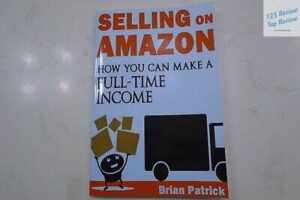In the ever-evolving world of e-commerce, Amazon stands as a colossal marketplace with millions of sellers vying for the attention of countless shoppers. For those looking to carve out a profitable niche in this vast landscape, “The Amazon Sales Formula” by Michael D. Marani offers a detailed and practical roadmap.
In this article, 123 Review provides an in-depth understanding of the essential strategies required to thrive on Amazon, from selecting the right products to scaling your business. In addition, we will delve deeper into the key concepts and strategies outlined in Marani’s book, giving you a thorough overview of how to succeed on Amazon.
Key Concepts of Selling on Amazon
Understanding Private Labeling
Private labeling is a cornerstone of Marani’s approach to selling on Amazon. This strategy involves finding generic products that are already popular or have the potential to become popular and branding them under your own label. Unlike selling products directly from manufacturers without customization, private labeling allows sellers to create a distinct brand identity, which is crucial in a crowded marketplace. By owning the brand, sellers gain more control over product quality, pricing, and customer perception, leading to higher profit margins and long-term brand loyalty.

Marani explains that private labeling also allows for greater flexibility in marketing. Since the product is branded under your own name, you can tailor your marketing efforts to highlight the unique aspects of your brand, setting yourself apart from competitors who may be selling similar, unbranded products. This differentiation is vital in a marketplace as competitive as Amazon, where customers are often overwhelmed with choices.
Benefits of Fulfillment by Amazon (FBA)
Fulfillment by Amazon (FBA) is another critical component of Marani’s strategy. FBA is a service offered by Amazon where the company handles the storage, packaging, and shipping of your products. For sellers, this means less hassle with logistics and more time to focus on other crucial aspects of the business, such as marketing and product development.
One of the most significant advantages of FBA is the increased visibility and credibility it provides. Products fulfilled by Amazon are eligible for Amazon Prime, which attracts a large base of loyal customers who prefer fast, free shipping. Additionally, FBA products are more likely to win the Buy Box, the prominent “Add to Cart” button on product listings, which can significantly boost sales.
Moreover, FBA takes care of customer service and returns, which can be particularly challenging for new sellers. By outsourcing these tasks to Amazon, sellers can ensure a smooth customer experience, which is essential for building positive reviews and repeat business.
Strategy for Identifying Profitable Products
Market Research Techniques
One of the first steps to succeeding on Amazon is identifying profitable products to sell. Marani emphasizes the importance of thorough market research to discover products that have high demand but are not overly saturated with competition. He outlines several techniques for conducting market research effectively.
One such technique is trend analysis. By keeping an eye on emerging trends, you can identify products that are gaining popularity but have not yet reached peak saturation. Tools like Google Trends, Amazon’s Best Sellers lists, and social media platforms can provide valuable insights into what consumers are currently interested in.
Another crucial aspect of market research is understanding your target audience. Marani advises sellers to delve into the demographics and psychographics of potential customers to determine what products will appeal to them. This includes analyzing customer reviews, forums, and social media discussions to understand pain points, preferences, and desires.
Tools for Analyzing Product Demand
In addition to traditional market research methods, Marani highlights the importance of using specialized tools to analyze product demand and competition. Tools such as Jungle Scout, Helium 10, and AMZScout are indispensable for any serious Amazon seller. These platforms provide detailed data on sales volumes, competition levels, and keyword trends, allowing sellers to make informed decisions about which products to invest in.
Jungle Scout, for instance, offers a product database that allows you to filter products based on various criteria such as price, demand, and competition. Helium 10 provides powerful keyword research tools that help you understand what customers are searching for on Amazon. AMZScout offers market analysis features that give you an overview of how competitive a particular niche is.
By leveraging these tools, sellers can identify profitable products with high demand and low competition, reducing the risk of investing in products that may not sell well.
Building a Brand on Amazon
Creating Unique Brand Identity
Building a strong brand is crucial for long-term success on Amazon. Marani emphasizes that a well-defined brand identity can set you apart from the competition and foster customer loyalty. Creating a unique brand identity involves several key elements, including designing a memorable logo, developing a consistent brand voice, and ensuring that your products meet high-quality standards.
Marani suggests starting with a clear understanding of your brand’s mission and values. What does your brand stand for? What problems does it solve for customers? By answering these questions, you can develop a brand message that resonates with your target audience.
Next, consider the visual aspects of your brand. Your logo, packaging, and product images should all reflect the personality and values of your brand. Consistency is key here; a cohesive brand image across all customer touchpoints—from your Amazon storefront to your social media profiles—helps build trust and recognition.
Developing Customer Loyalty
Once you have established a brand identity, the next step is to develop customer loyalty. Loyal customers are more likely to make repeat purchases and recommend your products to others, which is invaluable for growing your business.
Marani offers several strategies for fostering customer loyalty. One effective approach is to provide exceptional customer service. Promptly addressing customer inquiries, resolving issues efficiently, and going the extra mile to satisfy customers can leave a lasting positive impression.
Another strategy is to engage with customers through follow-up emails. After a purchase, sending a thank-you email, requesting feedback, or offering a discount on their next purchase can help build a connection with the customer. Additionally, creating a loyalty program that rewards repeat customers with exclusive discounts or early access to new products can further encourage them to stick with your brand.
Sourcing Products Effectively
Negotiating with Suppliers
Sourcing products is a critical step in the Amazon selling process, and Marani provides detailed advice on how to do it effectively. One of the most important aspects of sourcing is negotiating with suppliers. Effective negotiation can lead to better pricing, payment terms, and product quality, which are all essential for maintaining profitability.
Marani advises approaching negotiations with a clear understanding of your needs and goals. Before entering negotiations, research the supplier’s business, understand the market rates for the products, and be prepared to articulate why your business is a valuable partner for them. He also suggests building a relationship with the supplier based on trust and mutual respect, which can lead to better deals and long-term collaboration.
It’s also important to be clear about your expectations regarding product quality and delivery timelines. Marani recommends requesting samples before placing a large order and setting up clear quality control processes to ensure that the products meet your standards.
Finding Reliable Manufacturers
Finding reliable manufacturers is another crucial aspect of sourcing. Marani emphasizes the importance of thorough due diligence when selecting manufacturers. This includes researching potential manufacturers, checking their reputation, and visiting their factories if possible.
When evaluating manufacturers, Marani suggests considering factors such as production capacity, quality control processes, and communication skills. A manufacturer with a large production capacity may be able to scale with your business, while strong quality control processes ensure that the products meet your standards. Good communication is also vital; working with a manufacturer who is responsive and understands your requirements can prevent misunderstandings and delays.
Marani also advises against relying on a single manufacturer. Having multiple suppliers can provide a safety net in case one fails to deliver on time or if there are quality issues. Diversifying your supply chain can help mitigate risks and ensure a steady flow of products.
Optimizing Product Listings
Crafting Compelling Product Descriptions
A well-optimized product listing is essential for converting Amazon visitors into buyers. Marani stresses the importance of crafting compelling product descriptions that not only describe the product but also highlight its benefits and unique selling points.
To create an effective product description, Marani recommends focusing on the customer’s needs and desires. Instead of merely listing features, explain how those features benefit the customer. For example, if you’re selling a blender, don’t just say it has a powerful motor—highlight how that motor allows for smoother, faster blending, making it easier for customers to prepare their favorite smoothies.
Marani also suggests using bullet points to make the description easy to scan. Most customers won’t read through long paragraphs, so breaking the information down into concise bullet points can help them quickly grasp the key benefits of your product.
Utilizing SEO for Increased Visibility
Search engine optimization (SEO) is a critical factor in increasing your product’s visibility on Amazon. Marani provides a comprehensive guide on how to optimize your listings to appear in relevant search results.
The first step in optimizing your listing is keyword research. Identify the keywords that potential customers are using to search for products like yours. Tools like Helium 10 and AMZScout can help you discover high-volume keywords with low competition. Once you’ve identified these keywords, incorporate them naturally into your product title, bullet points, and description.
Marani also highlights the importance of backend search terms, which are keywords that you can include in your listing without them being visible to customers. These terms are crucial for ensuring that your product appears in as many relevant searches as possible.
Additionally, Marani advises paying attention to other elements of your listing, such as the product images and reviews. High-quality images that show the product from multiple angles, along with lifestyle shots, can significantly increase conversion rates. Encouraging positive reviews and managing negative ones are also essential for maintaining a strong product listing.
Leveraging Marketing Strategies
Amazon Advertising Options
Marketing your products effectively is key to driving traffic and sales on Amazon. Marani discusses various advertising options available on Amazon, including Sponsored Products, Sponsored Brands, and Sponsored Display ads.
Sponsored Products are pay-per-click (PPC) ads that appear in search results and on product detail pages. These ads are targeted based on keywords, and sellers only pay when a customer clicks on the ad. Marani suggests using Sponsored Products to increase visibility for new listings or to boost sales for slow-moving items.
Sponsored Brands, previously known as Headline Search Ads, allow sellers to promote their brand and product portfolio. These ads appear at the top of search results and feature your brand logo, a custom headline, and multiple products. Sponsored Brands are particularly effective for sellers looking to build brand awareness and drive traffic to their Amazon Storefront.
Sponsored Display ads are used to target customers based on their shopping behavior. These ads appear both on and off Amazon, reaching customers who have shown interest in similar products. Marani recommends using Sponsored Display ads to retarget customers who have visited your product listings but have not yet made a purchase.
Utilizing Social Media for Promotion
In addition to Amazon’s advertising options, Marani emphasizes the power of social media in promoting your Amazon products. Platforms like Facebook, Instagram, and Pinterest offer opportunities to reach a broader audience, engage with potential customers, and drive traffic to your Amazon listings.
Marani advises creating content that resonates with your target audience. This could include product demonstrations, customer testimonials, behind-the-scenes looks at your brand, and promotional offers. Visual platforms like Instagram and Pinterest are particularly effective for showcasing your products in a lifestyle context, helping customers visualize how they might use the products in their own lives.
Collaborating with influencers is another strategy Marani discusses. Influencers can help you reach a larger, more engaged audience by featuring your products in their content. Choosing influencers whose followers align with your target market can lead to increased brand awareness and sales.
Automating Your Sales Process
Setting Up Business Operations
Automation is a powerful tool for scaling your Amazon business. Marani emphasizes the importance of setting up efficient business operations that can run smoothly with minimal hands-on management.
One of the key areas for automation is order processing. Tools like Amazon’s FBA, as well as third-party software, can automate the entire order fulfillment process, from inventory management to shipping. This not only saves time but also reduces the risk of human error, ensuring that orders are processed quickly and accurately.
Inventory management is another area where automation can be beneficial. Automated inventory systems can track stock levels in real time, alert you when it’s time to reorder, and even place orders with suppliers automatically. This ensures that you never run out of stock, which can hurt your sales and rankings on Amazon.
Managing Customer Feedback and Reviews
Customer feedback and reviews are crucial for maintaining a positive reputation on Amazon. Marani provides strategies for managing this aspect of your business efficiently.
One of the first steps is to automate the process of requesting reviews. After a customer makes a purchase, you can set up automated emails thanking them for their purchase and politely requesting a review. Tools like FeedbackWhiz and Jungle Scout’s Review Automation can help streamline this process.
Managing negative feedback is equally important. Marani suggests setting up alerts for when you receive negative reviews so that you can address any issues promptly. By reaching out to dissatisfied customers and offering solutions, you can often turn a negative experience into a positive one, which may even result in the customer revising their review.
Generating Passive Income
Establishing a Revenue Management System
Generating passive income is one of the ultimate goals for many Amazon sellers. Marani highlights the importance of establishing a revenue management system that ensures consistent cash flow and profitability.
One key aspect of revenue management is tracking expenses and understanding your profit margins. Marani advises using accounting software to keep a close eye on all your business expenses, from manufacturing and shipping costs to advertising and Amazon fees. This allows you to identify areas where you can cut costs and improve profitability.
Reinvesting profits is another important strategy. Marani suggests using a portion of your profits to expand your product line, invest in marketing, or improve your operations. By continuously reinvesting in your business, you can fuel growth and increase your passive income over time.
Strategies for Scaling Your Business
Scaling your Amazon business requires a combination of strategic planning and execution. Marani provides several strategies for expanding your business, including launching new products, entering new markets, and increasing your marketing efforts.
Launching new products is one of the most effective ways to scale your business. Marani advises conducting thorough market research to identify complementary products that appeal to your existing customer base. By leveraging your existing brand and customer relationships, you can increase sales with minimal additional marketing effort.
Entering new markets is another growth strategy. Marani suggests exploring international Amazon marketplaces, such as Amazon UK, Amazon Germany, or Amazon Japan. Expanding into new markets can open up new revenue streams and reduce your reliance on a single market.
Finally, Marani emphasizes the importance of outsourcing tasks as your business grows. Delegating routine tasks, such as customer service, order processing, and bookkeeping, frees up your time to focus on strategic growth initiatives.
Success Stories and Case Studies
Examples of Successful Amazon Sellers
Throughout “The Amazon Sales Formula,” Marani includes success stories of Amazon sellers who have implemented his strategies and achieved significant growth. These examples provide valuable insights and inspiration for other sellers looking to replicate their success.
One such example is a seller who started with a single private label product and, by following Marani’s guidelines, expanded their product line and grew their revenue to six figures within a year. Another case study highlights a seller who used FBA and Amazon advertising to dominate a competitive niche, achieving a 300% increase in sales.
These success stories demonstrate the effectiveness of Marani’s strategies and provide real-world examples of how they can be applied to achieve success on Amazon.
Lessons Learned from Real Experiences
In addition to success stories, Marani also shares lessons learned from real-world experiences. He discusses common mistakes that sellers make and how to avoid them, providing practical advice based on his own experiences and those of other successful sellers.
One common pitfall is failing to adequately research the competition before launching a product. Marani stresses the importance of understanding the competitive landscape and choosing products that offer a unique value proposition. He also advises against launching products that are too similar to existing bestsellers, as it can be difficult to compete on price alone.
Another lesson learned is the importance of managing cash flow effectively. Many new sellers underestimate the costs associated with scaling a business, such as inventory, advertising, and Amazon fees. Marani provides tips on how to manage cash flow, including setting aside funds for reinvestment and planning for seasonal fluctuations in sales.
Challenges and Solutions in Amazon Selling
Common Pitfalls for New Sellers
Selling on Amazon is not without its challenges, especially for new sellers. Marani identifies several common pitfalls that new sellers often encounter and offers solutions to overcome them.
One of the biggest challenges is dealing with intense competition. Many niches on Amazon are highly competitive, with numerous sellers vying for the same customers. Marani advises new sellers to focus on finding niche markets with less competition or to differentiate their products through branding, packaging, or unique features.
Pricing is another challenge. New sellers often struggle to find the right balance between competitive pricing and maintaining healthy profit margins. Marani recommends using tools like Helium 10 or AMZScout to analyze competitors’ pricing strategies and to set prices that attract customers while still allowing for a profit.
Logistical issues can also pose significant challenges. Managing inventory, shipping, and returns can be overwhelming for new sellers, especially if they are handling everything themselves. Marani suggests using FBA to outsource these tasks to Amazon, allowing sellers to focus on growing their business rather than getting bogged down in logistics.
Strategies to Overcome Obstacles
To succeed on Amazon, sellers must be adaptable and resilient. Marani provides several strategies for overcoming obstacles and maintaining momentum.
One strategy is to anticipate and plan for challenges. For example, if you know that stockouts could be a potential issue, Marani advises building buffer stock or having backup suppliers in place. If you anticipate negative reviews, have a plan for addressing them quickly and professionally.
Another strategy is to continuously optimize your listings and marketing efforts. Marani suggests regularly reviewing your product listings, advertising campaigns, and customer feedback to identify areas for improvement. Small tweaks, such as optimizing keywords or refining ad targeting, can have a significant impact on your sales.
Finally, Marani emphasizes the importance of staying informed about changes in Amazon’s policies and algorithms. Amazon is constantly evolving, and staying up-to-date with the latest developments can help you adapt and avoid potential pitfalls.
“The Amazon Sales Formula” by Michael D. Marani is more than just a guide; it’s a comprehensive blueprint for building a successful business on Amazon. By understanding the key concepts, strategies, and challenges discussed in this article, sellers can navigate the complexities of the Amazon marketplace, optimize their operations, and achieve sustainable, long-term success. Whether you are just starting out or looking to take your existing Amazon business to the next level, the insights provided by Marani can serve as a valuable resource on your journey to e-commerce success.





